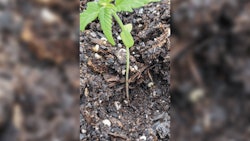
A wide variety of factors can impact substrate pH and plant growth, such as fertilizer type, substrate type, and water quality. Understanding how these three factors influence root zone pH is important for managing cannabis crop health and inputs.
High substrate pH (>6.5) can result in a decrease in micronutrient availability, potentially resulting in iron (Fe) deficiency (Figure 1). However, growers must also monitor for low pH problems, including reduced root growth or increased micronutrient availability that can result in Fe, manganese (Mn), or boron (B) accumulation (Figure 2). Figure 1. High substrate pH (>6.5) can result in a decrease in micronutrient availability, potentially resulting in iron (Fe) deficiency in the newly developing foliage.Photo by Brian Whipker
Figure 1. High substrate pH (>6.5) can result in a decrease in micronutrient availability, potentially resulting in iron (Fe) deficiency in the newly developing foliage.Photo by Brian Whipker
Water Quality
Water is the single largest input for growing cannabis. As such, it is an essential resource for growing healthy plants.
Elements in irrigation water can affect plant growth, especially in container-grown plants. That’s because container-grown plants have restricted root masses that are more sensitive to the soilless substrate’s low buffering capacity (the ability to regulate pH changes). Because of this, it is important to regularly monitor your irrigation water to be sure it is not creating nutrient imbalances and inhibiting plant growth.
Water quality varies depending on the source. The three sources of water growers most commonly used are well water, municipal water, and surface water. In many areas of North America, well water frequently contains high levels of dissolved elements, particularly alkalinity in the form of bicarbonates (HCO3–), calcium (Ca), and magnesium (Mg), which can lead to elevated substrate pH levels and tie up Fe availability to the plant. There are a variety of options to neutralize alkalinity, ranging from acidic fertilizers, acid injection, and reverse osmosis treatment. Figure 2. Low pH can result in increased micronutrient availability that can result in iron (Fe), manganese (Mn), or boron (B) accumulation in the lower foliage.Photo by Brian Whipker
Figure 2. Low pH can result in increased micronutrient availability that can result in iron (Fe), manganese (Mn), or boron (B) accumulation in the lower foliage.Photo by Brian Whipker
Municipal water obtained from rivers or lakes generally has a lower level of dissolved elements than well water. Because municipalities treat water with chloride (Cl) or fluoride (F) to meet drinking water quality standards, excessively high Cl and F levels may result in leaf margin burn. If Cl of F concentrations are elevated, water filters can be utilized to decrease concentrations to nontoxic levels for plants.
Surface or pond water usually contains lower levels of dissolved elements. Growers should be aware of the chemical composition of their surface water to ensure that they are providing adequate levels of Ca and Mg. In addition, caution should be used to protect the water source from herbicide runoff or pollution, which can be detrimental to plant growth.
Substrate
The desired properties of any container substrate are the same that make mineral soil ideal for outdoor-grown plants: proper root stability, water supply, nutrient reservoir and availability, and air (oxygen) content for proper root growth and development. A wide assortment of substrates for cannabis growers are available on the market, each with unique physical and chemical properties that influence plant growth and nutrient availability. Growers must select a substrate that meets all of these needs and works with their growing conditions.
Traditional soilless substrates are generally composed of 70% to 85% peat (acidic pH less than 5.0) and 15% to 30% aggregate, with preplant amendments such as limestone to raise the pH and nutrient charges to support early plant development. The choice of aggregate can vary widely, with options including perlite, bark, pumice stone, and biochar.
(Alternative substrates—such as coconut coir, wood fiber, and other organic components—have gained popularity and exhibit different physical and chemical properties compared to peat and should be managed independently.)
Evaluating the initial substrate pH before planting is critical to understanding its baseline conditions and anticipating potential shifts during production. Some substrates, such as peat-based mixes, tend to be naturally acidic and require limestone amendments to raise their pH to an optimal range. Conversely, coconut coir generally has a neutral to slightly acidic pH.
Variability in raw material sourcing and processing can cause fluctuations in substrate properties from year to year, making it essential for growers to test new batches before use. Conducting routine pH testing at the beginning of each growing season ensures that corrective actions, such as adjusting irrigation water or fertilizer selection, can be taken early to maintain optimal growing conditions for cannabis crops.
Proper substrate selection and management play a crucial role in maintaining consistent plant health and maximizing yield potential.
Fertilizer Selection
Fertilizers can fall into one of three categories: acidic, neutral, or basic. This is generally dictated by the ratio of ammoniacal (NH4+) (acidic) or nitrate (NO3-) (basic) nitrogen sources. Each fertilizer blend has a different amount of potential acidity or basicity (Table 1). Table 1. Potential acidity or basicity and theoretical neutralizing ability of commonly used commercial fertilizers at various ppm of nitrogen.Courtesy Brian Whipker
Table 1. Potential acidity or basicity and theoretical neutralizing ability of commonly used commercial fertilizers at various ppm of nitrogen.Courtesy Brian Whipker
Pairing a fertilizer that balances out the alkalinity in your irrigation water will help prevent the substrate pH from increasing above the recommended range.
Growers with high (>200 ppm calcium carbonate (CaCO3)) or moderate (75-200 ppm CaCO3) alkalinity in the irrigation water should consider selecting an acidic fertilizer that can neutralize the alkalinity while supplying adequate concentrations of calcium (Ca) and magnesium (Mg).
However, growers that observe low alkalinity in the irrigation water who select an acidic fertilizer may see a substantial decrease in substrate pH and experience micronutrient toxicity or decreased plant growth. If the alkalinity concentration in a water supply is low, growers should consider utilizing a basic Cal-Mag fertilizer to avoid pH drop and provide sufficient nutrients.
One additional consideration is that plants fertilized with NH4+ will exhibit greater stretch compared to plants fertilized with NO3-. Taking into account the alkalinity and other nutrients within the water, plus the nutrients supplied through the fertilizer, you can calculate the total nutrients supplied and make adjustments as needed.
Understanding how water quality, substrate composition, and fertilizer selection interact is essential for maintaining optimal growing conditions and preventing nutrient imbalances. And proactive management of water, substrate, and fertility programs leads to improved plant performance and overall production efficiency. By routinely monitoring pH and making necessary adjustments, growers can ensure consistent plant health and avoid potential issues before they become visible. Implementing in-house testing methods allows for early detection of pH fluctuations, reducing the risk of deficiencies or toxicities.
Patrick Veazie is a graduate research assistant pursuing an PhD. in the Department of Horticultural Science at North Carolina State University. His studies focus on alternative substrates.
Paul Cöckson is a graduate research assistant and Ph.D. candidate at the University of Kentucky Department of Plant and Soil Sciences. He is a part of the Hemp Agronomy team and is focusing on early germination and establishment of industrial hemp.
Dr. Brian E. Whipker, Ph.D., is a professor of floriculture at North Carolina State University specializing in plant nutrition, plant growth regulators and diagnostics. He co-authored eight scientific journal articles on the impact of fertilization with greenhouse species and three disorder diagnostic guides. Dr. Whipker has more than 30 years of greenhouse experience working with growers.


























